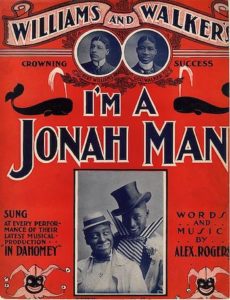
Williams and Walker, Program Flyer
*Williams and Walker's stage show is celebrated on this date in 1898. The twosome, George Walker and Bert Williams, were two of the most renowned figures of the minstrel era.
They debuted in New York at the Casino Theatre. Their act, "The Gold But," consisted of songs and dance focused on Walker trying to convince Williams to join him in get-rich-quick schemes. Later in life, Williams went on to a solo career and then worked for a company called the Ziegfeld Follies. The duo called themselves the "Two Real Coons" as most of the talent in vaudeville were primarily white and were painted in blackface. At first, the lighter-skinned Bert Williams would trick the darker Walker in their skits, but after a while, the two noticed the crowd reacted better when they reversed roles. Williams donned the burnt cork black face while George Walker, the "dandy," performed without makeup.
Blackface was said to work as a double mask for Williams as it emphasized that he was different from vaudevillians and white audiences. Williams played the role of the comic figure in blackface while George Walker played the straight man, an obvious counter to the dominant-negative stereotypes of the time. While performing their vaudeville act throughout the United States, the "Two Real Coons" headlined at the Koster and Bial's vaudeville house, where they popularized the cakewalk, a dance competition in which the winning couple was rewarded with a cake.
Offstage, life was different for the two men. Both men faced extreme racism. Racial prejudice was said to have shaped Bert Williams' career as he based his humor on universal situations in which it was possible that one of the audience members would find themselves. Often, white vaudevillians would refuse to appear on the same playbill as Williams, and it is said that others complained that his material was better than theirs. As a comedian and songwriter, he was loved by all. However, he often faced racism, even from the restaurants and hotels he played for. Williams was forced to perform in blackface makeup, gloves, and other attire as he consistently played out stereotypical black characters.
"George Walker fought against racism by providing a place within the company for colored artists, enabling a Black presence on stages nationwide. George Walker was an esteemed businessman managing the Walker and Williams Company affairs, which brought fame and wealth to those who worked for them nationally and internationally. In 1903, they performed """ In Dahomey," an elaborate play at Buckingham Palace in London. This was "the first full-length musical written and played by Blacks to be performed at a major Broadway house."
The play contained original music, props, and scenery. George Walker played a hustler disguised as a prince from Dahomey, sent by a group of deceitful investors to convince Blacks to join a colony."George Walker fought against racism by providing a place within the company for colored artists, enabling a Black presence on stages nationwide. George Walker was an esteemed businessman managing the Walker and Williams Company affairs, which brought fame and wealth to those who worked for them nationally and internationally.
"Other Williams and Walker Company productions include The Sons of Ham (1900), The Policy Players (1899), and Bandana Land (1908). Williams, Walker, and eight other members of their vaudeville troupe were initiated into Scottish Freemasonry on May 2, passed on May 16, and raised on June 1, 1904. On February 21, 1922, Williams collapsed on stage while performing and returned to New York City. He died a month later, on March 4, 1922.
’After Williams’ death, the Chicago Defender stated, "No other performer in the history of the American stage enjoyed the popularity and esteem of all races and classes of theater-goers to the remarkable extent gained by Bert Williams." ‘After Williams'’ death, the Chicago Defender stated, "No other performer in the history of the American stage enjoyed the popularity and esteem of all races and classes of theater-goers to the remarkable extent gained by Bert Williams."